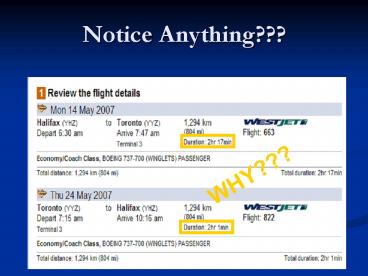Notice Anything - PowerPoint PPT Presentation
1 / 24
Title: Notice Anything
1
Notice Anything???
WHY???
2
Worldwide Wind Currents
3
Worldwide Wind Currents
- 3 factors
- Cool air traveling from N S to equator
- Closed air currents
- The earths rotation
4
PART ONE
- Cool air traveling from the north and south to
the equator
5
Earths Temperatures
- Where is the earths surface warmest, relatively?
- Where is the earths surface the coolest?
6
- Cool air travels from polar regions ? equator.
7
Part II
- Closed air currents
8
When cool air arrives at the equator, what do you
think happens?
9
- Warm air less dense, moves upwards.
- Cool air moves in to take its place
- This air will cycle, creating currents.
10
Air currents
Dont draw this yet!
11
- Because the earth is so big, it actually produces
3 closed currents in the north, and 3 closed
currents in the south.
12
3 Closed Currents
OK, draw this now
13
Part III
- The earths rotation
14
- Earth rotates at about 300 m/s (1080km/h)
- Does the atmosphere rotate with the Earth?
- Does it stay still while the Earth moves under
it? - HOW DO YOU KNOW???
15
- The atmosphere is moving with the earth.
- If it didnt, you would feel a constant wind of
1080km/h on Earths surface.
16
- Air in the atmosphere moves at same speed as
Earth below it. - Speed varies depending on the location on the
Earths surface.
17
Different points on Earth move at different speeds
18
Coriolis Effect
- The Coriolis Effect is a term used to describe
the influence the Earths rotation on air, or on
any object moving on the Earths surface.
19
- When convection moves air N or S, it also moves
East (in the northern hemisphere).
20
(No Transcript)
21
(No Transcript)
22
Animation
- http//www.physics.orst.edu/mcintyre/coriolis/Eas
t_QT.html
23
- In the northern hemisphere, the winds are called
the prevailing westerlies - (the wind comes from the west)
24
Notice Anything???































